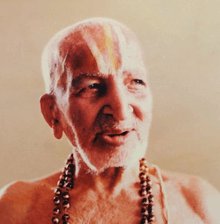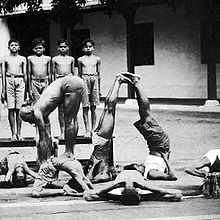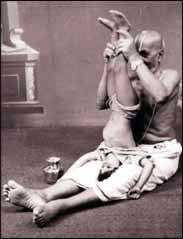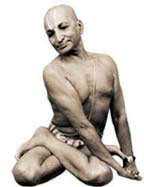Tirumalai Krishnamacharya
| Tirumalai Krishnamacharya | |
|---|---|
 Krishnamacharya at 100 years (1988) | |
| Born |
November 18, 1888 Chitradurga district, Mysore Kingdom |
| Died |
February 28, 1989 (aged 100) Madras, India |
| Nationality | Indian |
| Occupation | Yoga instructor |
| Known for | "the father of modern yoga" |
Tirumalai Krishnamacharya (November 18, 1888 – February 28, 1989)[3][4] was an Indian yoga teacher, ayurvedic healer and scholar. Often referred to as "the father of modern yoga,"[5][6][7] Krishnamacharya is widely regarded as one of the most influential yoga teachers of the 20th century and is credited with the revival of hatha yoga.[8]
Krishnamacharya held degrees in all the six Vedic darśanas, or Indian philosophies. While under the patronage of the Maharaja of Mysore, Krishna Raja Wadiyar IV, Krishnamacharya traveled around India giving lectures and demonstrations to promote yoga, including such feats as stopping his heartbeat.[9] He is widely considered as the architect of vinyasa,[8] in the sense of combining breathing with movement. Underlying all of Krishnamacharya’s teachings was the principle “Teach what is appropriate for an individual.”[10] While he is revered in other parts of the world as a yogi, in India Krishnamacharya is mainly known as a healer who drew from both ayurvedic and yogic traditions to restore health and well-being to those he treated.[8] He authored four books on yoga—Yoga Makaranda (1934), Yogaasangalu (c. 1941),[11] Yoga Rahasya, and Yogavalli (Chapter 1 - 1988)—as well as several essays and poetic compositions.[12] In 2012 his life and his teachings were depicted in the documentary film Breath of the Gods, which includes original footage of Krishnamacharya and interviews with relatives and students.
Some of Krishnamacharya's students include many of yoga’s most renowned teachers: his son T. K. V. Desikachar (b. 1938), Indra Devi (1900-2002), his brother-in-law B. K. S. Iyengar (b. 1918), K. Pattabhi Jois (1915-2009), and A. G. Mohan (b. 1945).
Biography
Early life
Krishnamacharya was born on November 18, 1888 in Muchukundapuram, situated in the Chitradurga district of present-day Karnataka, in South India, to an orthodox Iyengar family. His parents were Sri Tirumalai Srinivasa Tatacharya, a well-known teacher of the Vedas, and Shrimati Ranganayakiamma.[13] Krishnamacharya was the eldest of six children. He had two brothers and three sisters. At the age of six, he underwent upanayana.[14] He then began learning to speak and write Sanskrit, from texts such as the Amarakosha and to chant the Vedas under the strict tutelage of his father.[4] Krishnamacharya's father also taught him asanas and pranayama.
When Krishnamacharya was ten, his father died,[15] and the family had to move to Mysore, the second largest city in Karnataka, where Krishnamcharya's great-grandfather H.H. Sri Srinivasa Brahmatantra Parakala Swami, was the head of the Parakala Math (there were two by that name between 1835 - 1873 CE [16]). In Mysore, Krishnamacharya began a more formal schooling at the Chamaraj Sanskrit College and in the Math. He made a practice of debating on the subjects of the Shastras with the professors and visiting Pandits.[14] Krishnamacharya passed his Vidvan examination in Mysore, where he had studied Vyakarana, vedanta, and tarka.
At the age of sixteen, Krishnamacharya had a strange dream in which his ancestor, the legendary yogi and Sri Vaishnava saint Nathamuni directed him to go to the town of Alvar Tirunagari, in the neighboring state of Tamil Nadu. Krishnamacharya obeyed the dream and traveled there. As Krishnamacharya later told, when he arrived at his destination, he fell into a trance and found himself in the presence of three sages. He requested the sages to instruct him in the Yoga Rahasya, a long-lost yogic treatise by Nathamuni. One of the sages, whom he later identified as Nathamuni himself, began reciting the text. When Krishnamacharya later awoke from the trance, he could recall all the verses of this legendary treatise.
Scholastic education
Krishnamacharya spent much of his youth traveling through India studying the six darśana or Indian philosophies: vaiśeṣika, nyāya, sāṃkhya, yoga, mīmāṃsā and vedānta.[17] In 1906, at the age of eighteen, Krishnamacharya left Mysore to attend the university at Benares, also known as Vārānasī, a city of hundreds of temples and a highly regarded North Indian center of traditional learning.[18] While at the university, he focused his studies on logic and Sanskrit, working with Brahmashri Shivakumar Shastry, "one of the greatest grammarians of the age".[19] He also learned the Mimamsa from Brahmasri Trilinga Rama Shastri.[4] Krishnamacharya learned tarka from Vamacarana Bhattacharya. He also forged a strong friendship with the head of Kāśi Sanskrit Vidyā Pīṭha, Mahāmahopādhyāya Gaṅgānāth Jhā.
After leaving the Benares, in 1909, Krishnamacharya returned to Mysore and studied vedānta with the new pontiff of Parakāla Math, H. H. Sri Krishna Brahmatantra. During this period Krishnamacharya learned to play the vīṇā, one of the most ancient stringed instruments in India. Besides the Math, Krishnamacharya also studied at the University of Mysore.
In 1914, Krishnamacharya once again left for Benares to attend classes at Queens College, where he eventually earned a number of teaching certificates. During the first year he had little or no financial support from his family. In order to eat, he followed the rules that were laid down for religious beggars: he was to approach only seven households each day and was to offer a prayer "in return for wheat flour to mix with water for cakes".[20] Krishnamacharya eventually left Queens College to study the ṣaḍdarśana (six darshanas) in Vedic philosophy at Patna University, in Bihar, a state in eastern India. He also received a scholarship to study Ayurveda under Vaidya Krishnakumar of Bengal.[4]
Krishnamacharya was invited to the coronation of the Rajah of Dikkanghat (a principality within Darbhanga), at which he defeated a scholar called Bihari Lal in a debate, and received rewards and honors from the Raja.[21] His stay in Benares lasted 11 years.
Education in yoga
During all this time Krishnamacharya continued to practice the yoga that his father had taught him as a young boy. Krishnamacharya also studied with the yoga master Sri Babu Bhagavan Das and passed the Samkhya Yoga Examination of Patna.[4] Many of Krishnamacharya's instructors recognized his outstanding abilities in the study and practice of yoga and supported his progress. Some asked that he teach their children.[22]
During his vacations, which would last about three months, Krishnamacharya made pilgrimages into the Himalayas.[22] At the suggestion of Gaṅgānāth Jhā, Krishnamacharya sought to further his yoga studies by seeking a master named Yogeshwara Ramamohana Brahmachari, who was rumored to live in the mountains beyond Nepal. For this venture, Krishnamacharya had to obtain the permission of the Viceroy in Simla, Lord Irwin, who was then suffering from diabetes.[22] At the request of the Viceroy, Krishnamacharya travelled to Simla and taught him yogic practices for six months. The viceroy’s health improved and he developed respect and affection for Krishnamacharya.[23] In 1919, the Viceroy made arrangements for Krishnamacharya’s travel to Tibet, supplying three aides and taking care of the expenses.
After two and a half months of walking, Krishnamacharya arrived at Sri Brahmachari’s school, a remote cave at the foot of Mount Kailash, where the master lived with his wife and three children.[8] Under Brahmachari’s tutelage, Krishnamacharya spent seven and a half years[24] studying the Yoga Sūtras of Patañjali, learning āsanas and prāṇāyāma, and studying the therapeutic aspects of yoga”.[8] He was made to memorize the whole of the Yoga Kuruntha in the Gurkha language. As tradition holds, at the end of his studies with the guru, Krishnamacharya asked what his payment would be. The master responded that Krishnamacharya was to "take a wife, raise children and be a teacher of Yoga".[25]
Krishnamacharya then returned to Vārāṇasī. The Mahārāja of Jaipur called him to serve as principal of the Vidyā Śālā in Jaipur; but as he did not like being answerable to many people, Krishnamacharya shortly returned to Vārāṇasī. In accordance with his guru's wish that he live the life of a householder, Krishnamacharya married Namagiriamma in 1925. After his marriage, Krishnamacharya was forced by circumstance to work in a coffee plantation in the Hasan district. It was after a lecture on the Upaniṣads in Mysore town hall in 1931 that he attract the attention as a learned scholar that eventually led to his employment at the palace.[26] Impressed with Krishnamacharya’s knowledge as a scholar and his mastery of yoga, Amarnātha Jhā, the son of Gaṅgānāth Jhā, introduced Krishnamacharya to various monarchs, and he was widely honoured by them.
Mysore years

In 1926, the Maharaja of Mysore, Krishna Raja Wadiyar IV (1884-1940) was in Varanasi to celebrate the 60th birthday of his mother and heard about Krishnamacharya's learning and skill as a yoga therapist.[27] The Maharaja met Krishnamacharya and was so impressed by the young man's demeanor, authority, and scholarship that he engaged Krishnamacharya to teach him and his family.[27] Initially, Krishnamacharya was installed to teach yoga at the Mysore Palace.[28] He soon became a trusted advisor of the Maharajah, and was given the recognition of Asthana Vidwan — the intelligentsia of the palace.[29]
During the 1920s, Krishnamacharya held many demonstrations to stimulate popular interest in yoga. These included suspending his pulse, stopping cars with his bare hands, performing difficult asanas, and lifting heavy objects with his teeth.[8] The Palace archive records show that the Maharaja was interested in the promotion of yoga and continually sent Krishnamacharya around the country to give lectures and demonstrations.[30]
In 1931, Krishnamacharya was invited to teach at the Sanskrit College in Mysore. The Maharaja, who felt that yoga had helped cure his many ailments, asked Krishnamacharya to open a yoga school under his patronage[8][31] and was subsequently given the wing of a nearby palace, the Jaganmohan Palace, to start the Yogashala, an independent yoga institution,[28] which opened on August 11, 1933.[27][32]
In 1934, Krishnamacharya authored the book titled Yoga Makaranda, which was published by Mysore University. In the introduction to Yoga Makaranda, Krishnamacharya lists Sritattvanidhi, a 19th century treatise containing a yoga section by Maharaja of Mysore, Krishnaraja Wodeyar III (b. 1794 - d. 1868) as one of the sources for his book. In The Yoga Tradition of the Mysore Palace, Norman Sjoman asserts that Krishnamacharya was influenced by the Sritattvanidhi and also the Vyayama Dipika, a Western based gymnastics manual written by the Mysore Palace gymnasts.[33]
In 1940, Krishna Raja Wadiyar IV died and his nephew and successor, Jayachamarajendra Wadiyar (1919-1974), showed less interest in yoga and no longer provided support for publishing texts and sending teams of teachers to surrounding areas.[34] Following political changes in 1946, around the time that India gained independence, the powers of the maharajas were curtailed, a new government came into being. Funding for the yoga school was cut off[35] and Krishnamacharya struggled to maintain the school. At the age of 60 (1948), Krishnamacharya was forced to travel extensively to find students and provide for his family.[35] The yogashala in Mysore was ordered to be closed by K.C. Reddy, the first Chief Minister of Mysore State, and the school eventually closed in 1950.[8]
Madras years

In Madras, Krishnamacharya accepted a job as a lecturer at Vivekananda College. He also began to acquire yoga students from diverse backgrounds and in various physical conditions, which required him to adapt his teaching to each student’s abilities. For the remainder of his teaching life, Krishnamacharya continued to refine this individualized approach, which came to be known as Viniyoga.[8][37] Many considered Krishnamacharya a yoga master, but he continued to call himself a student because he felt that he was always “studying, exploring and experimenting” with the practice.[38] Throughout his life, Krishnamacharya refused to take credit for his innovative teachings but instead attributed the knowledge to his guru or to ancient texts.[8]
At the age of 96, Krishnamacharya fractured his hip. Refusing surgery, he treated himself and designed a course of practice that he could do in bed. Krishnamacharya lived and taught in Chennai until he slipped into a coma and died in 1989, at one hundred years of age. His cognitive faculties remained sharp until his death; and he continued to teach and heal whenever the situation arose.
Revival of hatha yoga

Approach to healing
Krishnamacharya was not only a yoga instructor but also a physician of Ayurvedic medicine. He “possessed enormous knowledge of nutrition, herbal medicine, the use of oils, and other remedies”.[39] Krishnamacharya’s custom as an Ayurvedic practitioner was to begin by conducting a detailed examination to determine the most efficient path to take for a patient. For example, he would take the patient’s pulse, examine the color of the skin, and listen to the quality of the breath. During the time of diagnosis, Krishnamacharya would look for what “upset or hindered the harmonious union of the body, mind, and spirit.”[40] According to Krishnamacharya, even though the source or focus of a disease is in a particular area of the body, he assumed that many other systems in the body, both mental and physical, but also be affected. At some point during or after an initial examination, Krishnamacharya would ask if the patient was willing to follow his guidance. This question was important to a patient’s treatment, because Krishnamacharya felt that if the person could not trust him fully there was little chance of his or her being healed.[41]
Once a person began seeing Krishnamacharya, he would work with him or her on a number of levels including adjusting their diet; creating herbal medicines; and setting up a series of yoga postures that would be most beneficial. When instructing a person on the practice of yoga, Krishnamacharya particularly stressed the importance of combining breath work (pranayama) with the postures (asanas) of yoga and meditation (dhyana) to reach the desired goal.[42] He would continue to see the person approximately once a week to monitor the progress until he or she was healed.
Approach to yoga

Accomplishment as a scholar
Krishnamacharya was highly regarded as a scholar. He earned degrees in philosophy, logic, divinity, philology, and music.[8][49] He was twice offered the position of Acharya in the Srivaishnava sampradaya, but he declined in order to stay with his family, in accordance with his guru’s wishes.[8]
He also had extensive knowledge of orthodox Hindu rituals. His scholarship in various darshanas of orthodox Indian philosophy earned him titles such as Sāṃkhya-yoga-śikhāmaṇi, Mīmāṃsā-ratna, Mīmāṃsā-thīrtha, Nyāyācārya, Vedāntavāgīśa, Veda-kesari and Yogācārya.[50]
Works
Books on yoga:[51]
- Yoga Makaranda (1934)
- Yogaasanagalu (c. 1941)
- Yoga Rahasya
- Yogavalli (Chapter 1 - 1988)
Other works (essays and poetic compositions):[52]
- “Yogaanjalisaaram”
- “Disciplines of Yoga”
- “Effect of Yoga Practice”
- “Importance of Food and Yoga in Maintaining Health”
- “Verses on Methods of Yoga Practice”
- “Essay on Asana and Pranayama”
- “Madhumeha (Diabetes)”
- “Why Yoga as a Therapy Is Not Rising”
- “Bhagavad Gita as a Health Science”
- “Ayurveda and Yoga: An Introduction”
- “Questions and Answers on Yoga” (with students in July 1973)
- “Yoga: The Best Way to Remove Laziness”
- “Dhyana (Meditation) in Verses”
- “What Is a Sutra?”
- “Kundalini: Essay on What Kundalini Is and Kundalini Arousal (sakti calana) Based on Texts Like the Hatha Yoga Pradipika, Gheranda Samhita, and Yoga Yajnavalkya”
- “Extracts from Raja Yoga Ratnakara”
- “Need for a Teacher”
- “Satvika Marga” (“The Sattvic Way”; philosophy/spiritual/yoga)
- “Reference in Vedas to Support Vedic Chanting for Women” (philosophy/technical)
- “Fourteen Important Dharmas” (philosophy)
- “Cit Acit Tatva Mimamsa” (philosophy)
- “Sandhya-saaram” (ritual) “Catushloki” (four verses on Sankaracharya)
- “Kumbhakonam Address” (catalog) “Sixteen Samskaras” (rituals)
- “Mantra Padartha Tatva Nirnaya” (rituals)
- “Ahnika Bhaskaram” (rituals)
- “Shastreeya Yajnam” (rituals)
- “Vivaaha” (marriage rituals)
- “Asparsha Pariharam” (rituals)
- “Videsavaasi Upakarma Nirnaya” (rituals)
- “Sudarshana Dundubhi” (devotional)
- “Bhagavat Prasadam” (devotional)
- “Narayana Paratva” (devotional)
- “About Madras” (miscellaneous)
Notes
- ↑ Desikachar, T. K. V., Health, Healing, & Beyond, p. 52
- ↑ Krishnamacharya, Tirumalai (1934). Yoga Makaranda. Mysore University.
- ↑ Mohan, Krishnamacharya: His Life and Teachings, p. 125.
- ↑ 4.0 4.1 4.2 4.3 4.4 http://www.kym.org/tkrish.html
- ↑ "Krishnamacharya - Father of Modern Yoga". About.com. July 15, 2011. Retrieved October 10, 2011.
- ↑ "Memories of a Master". YogaJournal.com. Retrieved October 10, 2011.
- ↑ "The YJ Interview: Partners in Peace". YogaJournal.com. Retrieved October 10, 2011.
- ↑ 8.0 8.1 8.2 8.3 8.4 8.5 8.6 8.7 8.8 8.9 8.10 8.11 8.12 8.13 8.14 Ruiz 2001.
- ↑ Mohan, Krishnamacharya: His Life and Teachings, p. 7.
- ↑ Mohan, Krishnamacharya: His Life and Teachings, p. 38.
- ↑ Singleton, Mark (2010). Yoga Body: The Origins of Modern Posture Practice (Kindle Edition ed.). USA: Oxford University Press. p. Kindle Locations 3162–3163. ISBN 978-0195395341.
- ↑ Mohan, Krishnamacharya: His Life and Teachings, pp. 128-130.
- ↑ Mohan, Krishnamacharya: His Life and Teachings, p. 1.
- ↑ 14.0 14.1 http://aysnyc.org/index.php?option=com_content&task=view&id=41&Itemid=37
- ↑ Pierce, Martin (January–February 1988). "A Lion in Winter". Yoga Journal: 61–62.
- ↑ http://www.parakalamatham.org/taxonomy/term/11
- ↑ http://www.kheper.net/topics/eastern/6darshanas.htm.
- ↑ Mohan, Krishnamacharya: His Life and Teachings, p. 2.
- ↑ Desikachar, T. K. V., Health, Healing, & Beyond, p. 38
- ↑ Desikachar, T. K. V., Health, Healing, & Beyond, p. 40.
- ↑ http://aysnyc.org/index.php?option=com_content&task=view&id=41&Itemid=184
- ↑ 22.0 22.1 22.2 Mohan, Krishnamacharya: His Life and Teachings, p. 3.
- ↑ Mohan, Krishnamacharya: His Life and Teachings, pp. 3-4.
- ↑ Mohan, Krishnamacharya: His Life and Teachings, p. 5.
- ↑ Desikachar, T. K. V., Health, Healing, & Beyond, p.44
- ↑ Singleton, Mark (2010). Yoga Body: The Origins of Modern Posture Practice. Oxford: Oxford University Press. p. 273. ISBN 978-0-19-539535-8. p. 197
- ↑ 27.0 27.1 27.2 Desikachar, T. K. V., Health, Healing, & Beyond, p. 87
- ↑ 28.0 28.1 Sjoman, N.E. (1999). The Yoga Tradition of the Mysore Palace (2nd ed.). New Delhi, India: Abhinav Publications. p. 52. ISBN 81-7017-389-2.
- ↑ Iyengar, B.K.S. (2000). Astadala Yogamala. New Delhi, India: Allied Publishers. p. 53. ISBN 978-8177640465.
- ↑ Sjoman, N.E. (1999). The Yoga Tradition of the Mysore Palace (2nd ed.). New Delhi, India: Abhinav Publications. p. 53. ISBN 81-7017-389-2.
- ↑ Mohan, Krishnamacharya: His Life and Teachings, p. 6.
- ↑ Singleton, Mark (2010). Yoga Body: The Origins of Modern Posture Practice (Kindle Edition ed.). USA: Oxford University Press. p. Kindle Locations 3481–3482. ISBN 978-0195395341.
- ↑ Cushman, Anne. "Yoga Through Time". Yoga Journal.
- ↑ Desikachar, T. K. V., Health, Healing, & Beyond, p. 94
- ↑ 35.0 35.1 Desikachar, T. K. V., Health, Healing, & Beyond, p. 96
- ↑ Desikachar, T. K. V., Health, Healing, & Beyond, p. 101
- ↑ Mohan, Krishnamacharya: His Life and Teachings, pp. 38-43.
- ↑ Desikachar, T. K. V., Health, Healing, & Beyond, p. 104
- ↑ Desikachar, T. K. V., Health, Healing, & Beyond, p. 124
- ↑ Desikachar, T. K. V., Health, Healing, & Beyond, p. 129
- ↑ Desikachar, T. K. V., Health, Healing, & Beyond, p. 131
- ↑ Desikachar, T. K. V., Health, Healing, & Beyond, p. 111
- ↑ Desikachar, T. K. V., Health, Healing, & Beyond, p. 123
- ↑ Desikachar, T. K. V., The Heart of Yoga, p. xviii
- ↑ Mohan, Krishnamacharya: His Life and Teachings, p. 107.
- ↑ Desikachar, T. K. V., Health, Healing, & Beyond, p. 20
- ↑ Desikachar, T. K. V., Health, Healing, & Beyond, p. 22
- ↑ Desikachar, T. K. V., The Heart of Yoga, p. xix
- ↑ Mohan, Krishnamacharya: His Life and Teachings, pp. 3-5.
- ↑ http://archives.chennaionline.com/Personality/art012.asp
- ↑ Mohan, Krishnamacharya: His Life and Teachings, pp. 128-129.
- ↑ Mohan, Krishnamacharya: His Life and Teachings, pp. 129-130.
References
- Desikachar, T.K.V. & Cravens, R.H. Health, Healing & Beyond : Yoga and the living tradition of Krishnamacharya. Aperture, 1998. ISBN 0-89381-941-7
- Mohan, A. G. (2010). Krishnamacharya: His Life and Teachings. Boston: Shambhala. ISBN 978-1-59030-800-4.
- Ruiz, Fernando Pagés. "Krishnamacharya's Legacy." YogaJournal.com and Yoga Journal, May/June 2001.
External links
|